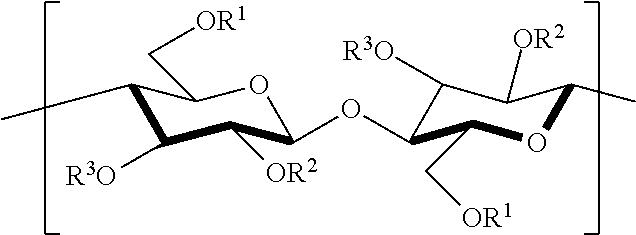Polymer-based resin compositions derived from cellulose and articles made using these compositions
a technology of polymer-based resins and compositions, which is applied in the direction of coatings, etc., can solve the problems of limiting the range of applications for which they can be used, reducing hdt, and limiting the use of cellulose ester materials, so as to reduce the amount of plasticizer, eliminate the use of plasticizer, and improve the effect of physical properties
- Summary
- Abstract
- Description
- Claims
- Application Information
AI Technical Summary
Benefits of technology
Problems solved by technology
Method used
Image
Examples
example 1
[0174]Example 1 was prepared by mixing Eastman™ CAP 482-20 (18.484 lb, 92.42 wt %), ECO 100 (1.2 lb, 6.0 wt %), IRGANOX 1010 (0.05 lb, 0.25 wt %), IRGAFOS 168 (0.066 lb, 0.33 wt %), DRAPEX 4.4 (0.194 lb, 0.97 wt %), SNMO (0.0006 lb, 0.03 wt %) in a Hobart mixer for 20 minutes at room temperature.
[0175]A series of compositions were made to determine the effect of different stabilizers on critical properties as noted in the examples in Table 1. The base material used for these examples was Eastman™ CAP 482-20.
TABLE 1Ex. 2-13Prim.Second.AcidSaltCE,IM,Antiox.,Antiox.,Scav.,Stab.,EX #Wt %(Wt %)(Wt %)(Wt %)(Wt %)(Wt %)2CAP 482-20NPPPDRAPEX 4.4SNMO(98.98)(0.10)(0.90)(0.02)3CAP 482-20ECO100NPPPDRAPEX 4.4SNMO(92.98)(6.0)(0.10)(0.90)(0.02)4CAP 482-20ECO100ULTRANOX 626DRAPEX 4.4SNMO(92.97)(6.0) (0.33%)(0.68)(0.02)5CAP 482-20ULTRANOX 626DRAPEX 4.4SNMO(98.97)(0.33)(0.68)(0.02)6CAP 482-20ECO100IRGANOX 1010ULTRANOX 626DRAPEX 4.4SNMO(92.72)(6.0)(0.25)(0.33)(0.68)(0.02)7CAP 482-20ECO100IRGANOX 1010...
PUM
| Property | Measurement | Unit |
|---|---|---|
| flexural modulus | aaaaa | aaaaa |
| mold thickness | aaaaa | aaaaa |
| mold thickness | aaaaa | aaaaa |
Abstract
Description
Claims
Application Information
 Login to View More
Login to View More - R&D
- Intellectual Property
- Life Sciences
- Materials
- Tech Scout
- Unparalleled Data Quality
- Higher Quality Content
- 60% Fewer Hallucinations
Browse by: Latest US Patents, China's latest patents, Technical Efficacy Thesaurus, Application Domain, Technology Topic, Popular Technical Reports.
© 2025 PatSnap. All rights reserved.Legal|Privacy policy|Modern Slavery Act Transparency Statement|Sitemap|About US| Contact US: help@patsnap.com

